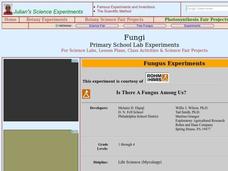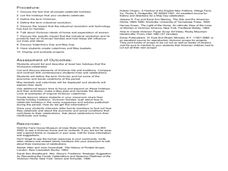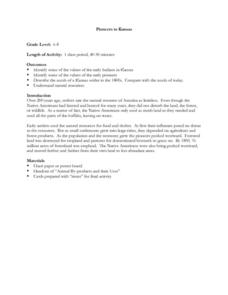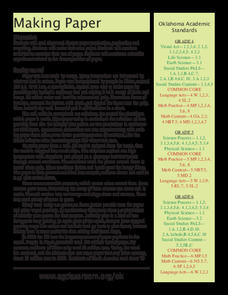Curated OER
Diggin' The Past
Students explore the culture of Ancient Egypt. In this ancient civilizations lesson, students are divided into groups to research how aspects of culture were influenced by the Nile River. Students create a slide show that describes how...
Curated OER
Texas, Yes!
In this Texas worksheet, students watch the video Texas, Yes! by America's Heartland and answer short answer questions about it. Students answer 5 questions.
Curated OER
Fungi
Students examine the characteristics of fungi. In this biology lesson, students investigate the factors needed for fungi growth. They collect data and observations and write a report about them.
Curated OER
Victorian Celebrations
Fifth graders investigate the Victorian era by participating in Victorian style activities. In this World History lesson plan, 5th graders read about the traditions and customs of men and woman from the Victorian era and how the...
Curated OER
Farming Idaho
Young scholars use a digital atlas to explore areas in the Western United States that depend heavily upon water. They explore the type of soil and the farming that is compatible with the soil. As a class, students explore Idaho's...
Curated OER
Arkansas- Economic System
Young scholars investigate how the six natural regions of Arkansas work together to form the economic system of the state. They read a paragraph and articles about the state and complete an activity that demonstrates interdependence....
Curated OER
North V. South And The Bank Creation
Eighth graders investigate the economic status of America during the 1800's and the role of the bank in the early times of our country. They concentrate on the different jobs that people had in the North and South while classifying them...
Curated OER
Christmas Tree Farming in Ontario
Pupils realize that Christmas trees produced in Ontario are a field crop that is harvested annually. They find out that Christmas tree farming is important to the economy and the environment of our province.
Curated OER
Eggstra Safe Eggs
Students study about the bacteria that grow in eggs. They examine what farmers do to keep eggs safe such as providing clean environments in the chicken house.
Curated OER
Grain Properties Activity
Learners study the similarities and differences of five different grains. They analyze the characteristics of corn, sunflower, milo, wheat, and soybeans.
Curated OER
Trade Gives Us Access to Things We Wouldn't Otherwise Have
Students work together in groups to research an item related to trade. They decide on an item that they use and determine where it comes from. They track the sources and consumers on a map.
Curated OER
Where In The World?
Learners identify the goods and services from the United States and Mexico. Using postage stamps, they describe the various images they see and place them into categories. They use those categories to determine what is important in...
Curated OER
Lesson 1
Students understand the meaning of natural resources. They distinguish between renewable and non-renewable natural resources. To help students identify natural resources as either non-renewable or renewable. To stimulate student thinking...
Curated OER
Life Is Like a Jar of Pickles
Fourth graders examine how a jar of pickles impacts the Earth. They make predictions on how it can effect their quality of life and suggest improvements in different fields. They share their suggestions with the class.
Curated OER
Wisconsin Snapshots
Fourth graders study Wisconsin's culture and heritage. They research the state's symbols and identify leaves common to the Wisconsin area. They create a leaf booklet and visit the state park. They visit local farms and create nature maps...
Curated OER
Industrial Revolution
Eighth graders examine the conditions of workers during the Industrial Revolution. Using the internet, they select three personal statements from workers and others to develop their own conclusions. They answer discussion questions about...
Curated OER
Do we Really Need Wild Nature
Students research challenges with which modern biotechnology confronts wild nature. Students collect articles that relate to biotechnology and the environment. Students prepare a collaborative answer to the question, "Do we really need...
Curated OER
Microorganism Multiplication
Seventh graders complete two experiments to learn about harmful and helpful microorganisms. In this microorganisms lesson plan, 7th graders read background information about fungi, yeast, and club fungi. Students then complete two...
Curated OER
Pioneers to Kansas
Students investigate items for basic survival, needed for survival, and luxury items. They compare what they need to what Indians and Pioneers needed in the 1700's and 1800's.
Curated OER
Making Paper
Fourth graders investigate the paper usage in their classroom and in other countries by using estimation, counting, and measurement skills. They make paper from recycled paper.
Curated OER
Foods for Better Health
Students define biotechnology and discuss the economic impact of biotechnology. They also describe what a 1015 onion and a slow-softening tomato are and how they are produced. They examine the safety of genetically-engineered or altered...
Curated OER
Learning about Biotechnology and GMO’s
Tenth graders describe the different methods of biotechnology. In this biology lesson plan, 10th graders assess the pros and cons of using GMO's. They create posters that either supports or discourages its use.
Curated OER
Measurement: When Degrees Matter
Eighth graders record the temperature change of the beakers. For this general science lesson, 8th graders create their own data table for recording observations. They discuss experimental results and cite real life applications.
Curated OER
The World Population Explosion
High schoolers are introduced to some of the fundamental questions about the connections among population, resources and energy use, and environmental impacts. They explore population growth, interpret a line graph and calculate their...























